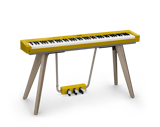How a Perfectly Placed Piano Can Bring Harmony to Your Home
Partner Story

While good design can be captivating to look at, great design can be a feast for the senses. Incorporating a piano into your space can elicit auditory bliss, but considering a few simple decorating tips will ensure your home’s design hits all the right notes.
When designing around a piano, or other statement instrument, it’s important to consider acoustics as well as aesthetics. "Each room has its own sound, and it's affected by flooring, wall decor, and windows," explains Rich Formidoni, Product Marketing Manager for Casio America. Too many hard, flat surfaces can bounce sound waves and negatively impact sound quality. Consider adding a rug or soft textiles to dampen unwanted reverberation and minimize distortion. Because sound waves can reflect off walls, instrument placement is also key—depending on the type and class, optimal sound quality may be best achieved by distancing the instrument from the wall.
Stylistically, a piano should complement your home’s decor—whether modern or traditional, eclectic or understated, rustic or refined. "Furniture-style pianos are sizable additions to a room, so it's important to make sure the aesthetics match the feel of the space," says Formidoni. Identify a few key furniture items or accessories that pair well with the piano, and play with spacing around the room. With common design threads woven throughout, a well-placed piano can elevate the cohesion of the space.
To decorate around a musical statement piece, consider how often the instrument is used—daily, weekly, or occasionally—and identify a location in the room where ease of access matches frequency of use. For a piano or other sizable instrument, be sure the placement does not interfere with foot traffic in the room—allow at least two to three feet of clearance between the piano and other furnishings or obstructions to ensure a comfortable path of circulation for residents and guests.
Shop the Look
Selecting a design-forward piano for your space can simplify the integration process, making it easy—and practical—to feature the instrument as a focal point. Designed to be showcased, the Privia PX-S7000 from Casio, for example, is a next-generation electric piano created with the design enthusiast in mind. The Privia PX-S7000 is available in three statement colors—black, white, and a midcentury-inspired mustard. "The PX-S7000 begs to be seen as well as heard," says Formidoni. "There’s nothing out there that looks or sounds anything like it."
Privia’s 88-key keyboard rests atop a solid beech stand with color-coordinated pedals in a fixed position, which honor the setup of a traditional piano. The glossy white keys are composed of wood and resin—each key has an elegant spruce side, while the slightly textured resin surface offers tactile familiarity with actual piano keys for an intuitive playing experience.
All too often, electric pianos are relegated to a perimeter wall or corner—tucked out of sight for occasional use. Casio’s Privia PX-S7000, by contrast, is compact enough to fit against a wall, but bold enough to be your room’s centerpiece. The Privia’s sleek frame allows you to see "through" it much more than traditional pianos. Taking up less visual space, the PX-S7000’s design gives users freedom to place it nearly anywhere in the room—without obstructing sightlines or inhibiting flow.
Striking from every angle, the sleek and sculptural design boldly reinterprets a classic form. "A Privia PX-S7000 owner is someone who is conscious of the effect that design choices have on their life," shares Formidoni.
Learn more about the Privia series at casio.com.
Published
Last Updated
Topics
How-To & GuidesGet the Dwell Newsletter
Be the first to see our latest home tours, design news, and more.










